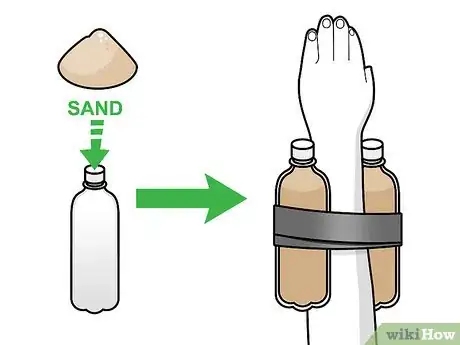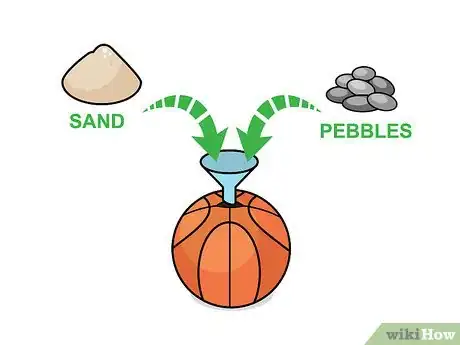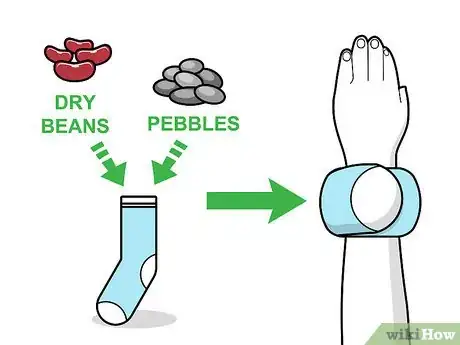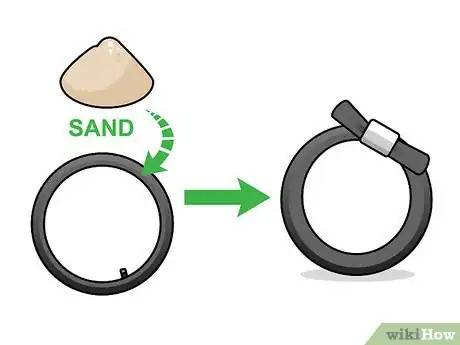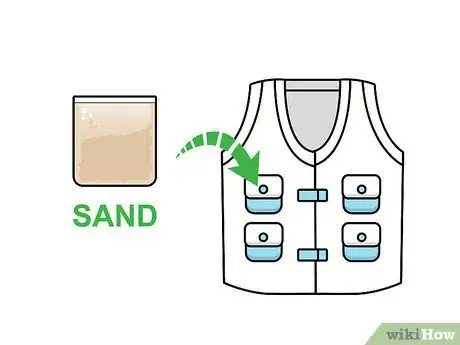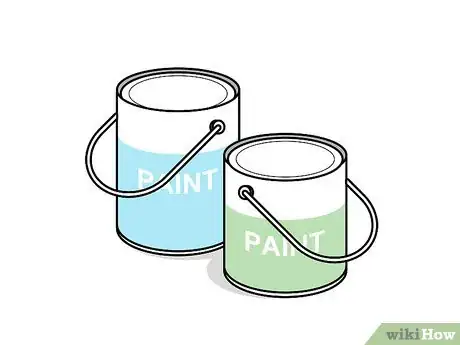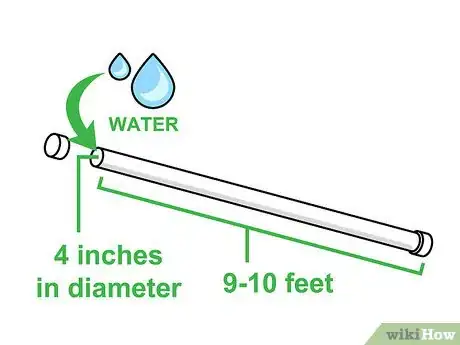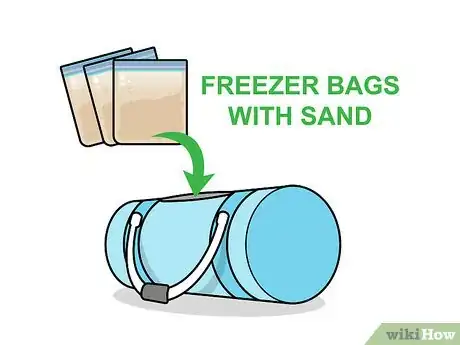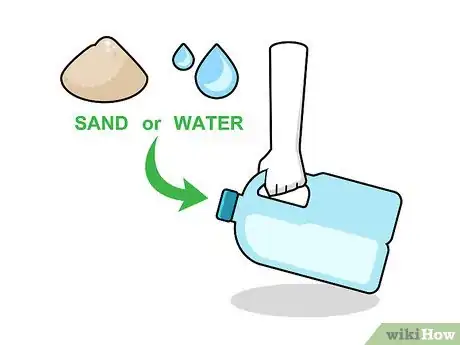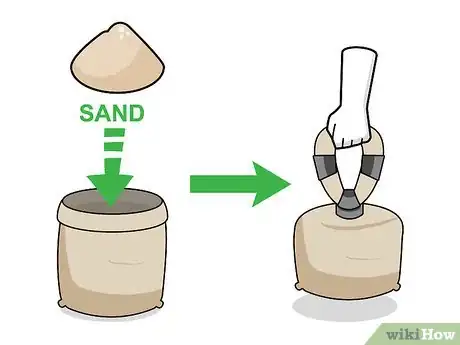This article was co-authored by Laila Ajani. Laila Ajani is a Fitness Trainer and founder of Push Personal Fitness, a personal training organization based in the San Francisco Bay Area. Laila has expertise in competitive athletics (gymnastics, powerlifting, and tennis), personal training, distance running, and Olympic lifting. Laila is certified by the National Strength & Conditioning Association (NSCA), USA Powerlifting (USAPL), and she is a Corrective Exercise Specialist (CES).
There are 8 references cited in this article, which can be found at the bottom of the page.
wikiHow marks an article as reader-approved once it receives enough positive feedback. This article received 17 testimonials and 88% of readers who voted found it helpful, earning it our reader-approved status.
This article has been viewed 1,245,316 times.
Weights for improving your strength and fitness can be made out of many common household items. Milk jugs, canned goods and assorted everyday objects can help you stay in shape. So save your money and keep fit all at once!
Steps
Making Lighter Homemade Weights
-
1Use a milk jug.[1] Fill a clean, plastic gallon jug with water, sand, rocks, or concrete. Make sure that the jug has a handle; you will use this to complete your exercise reps. Use the handles to lift and lower the jug like you would any hand weight or dumbbell.
- With milk jug hand weights, you can do bicep curls, tricep exercises, bent-over rows, pec flyes, deadlifts, and shoulder raises.
- You can also hold these weights to your sides when you are doing squats or lunges.[2]
-
2Lift canned goods. Canned goods that fit into your hands work well as simple hand weights. This is especially good if you are starting out and trying to build muscles slowly. Use larger canned goods as heavier weights or medicine balls.Advertisement
-
3Make dumbbells from plastic water bottles. Instead of recycling your plastic water and soda bottles, refill them with water, or put pebbles or sand in them instead. When filling them, make sure to weigh them so the weights are the same for both hands. Lift the bottles like you would any dumbbell.[3]
-
4Make arm weights with water bottles. Instead of using the water bottles for hand weights, this method attaches multiple bottles to your arms like wrist weights. Before you put them on your arms, fill them with sand. For heavier weights, add water after you fill them completely with sand.
- When they are filled, scotch tape the plastic bottles all the way around your forearm. The tape does not touch your skin; it only touches the bottles to hold them together. You can also use duct tape, just don't attach it to your skin. Place the bottles just tight enough so they do not slide off your arms.
-
5Make a weighted medicine ball from a basketball. Take an old basketball and drill a hole into one of the black stripes. The hole should be big enough to funnel in the weighted material. Place a funnel in the hole and fill with sand or pebbles until you have achieved the desired weight. Use a bike tire patch kit to fill the hole. You can also use duct tape if you don't have a tire patch kit.[4] The repurposed ball can now be used just like a medicine ball.
-
6Make wrist weights from socks. Fill a clean sock with dry beans. Alternately, use pebbles or small craft rocks for a heavier weight. Sew or glue the open end of the sock closed. Then, sew the ends together, or sew Velcro onto the ends so you can remove it easily.
- Use a scale to adjust the weight. Fill the sock as full as you want based on weight and then cut the excess fabric. If you want to make heavier weights but the inside material won't fit, use a larger sock.
- When choosing a sock, make sure to choose one long enough to wrap around your wrist. If the sock is too long, fill it until it will wrap around your wrist, then cut the excess fabric before closing the end.
-
7Use packets of rice or beans. These packages are great for mini-weights if you are a beginner. You can use them right from the cabinet for bicep curls and other small weight-lifting moves.
-
8Cut bicycle tire tubes into hand weights. Take a bicycle inner tube and cut it into equal lengths. Secure one end of the tube with duct tape, then fill the tube with sand. Close the other end with duct tape. You can either leave them flat or bend them into circles until the two ends are touching and secure the ends together with duct tape.[5]
- This is a great method for making weights of different sizes. Start with 1 or 3 pounds. You can also try 5 or even 8 pound weights. Use a scale to weight out the weights before you close them.
-
9Make a weighted vest. Get a fishing vest or a vest with multiple small pockets. Fill plastic bags with sand or concrete and place in all the pockets. Run, do pull ups, push ups, or go walking while wearing the weighted vest.[6]
-
10Use paint cans. Hold paint cans in your hands by their handles. Most paint cans are a little heavier than plastic bottles or cans of food, so you can use them as you build muscle. The handles allow you to use the cans like dumbbells.
Making Heavier Homemade Weights
-
1Use 5 gallon (18.9 L) buckets. Fill a 5 gallon (18.9 L) bucket with sand, rocks, concrete, or even water. Use it to do curls or attach two of them to a bar or board and use as a bench press.
-
2Make a barbell with water bottles. Take 2 packs of 6 bottles each and duct tape them symmetrically to an iron bar you can grip easily. This barbell will be good for any exercise you do with a barbell, like lifts and presses.
- If these 2 packs are too much, don't use half filled bottles. Half-filled bottles will slosh around and shake the bar. Instead, tape individual filled bottles to the bar.
- If 2 packs aren't enough, use four or six packs of bottles taped to the bar. Alternately, tape individual bottles to each end of the bar. First line them horizontally along the bar side by side, then stack them on top of each other. Make sure to leave plenty of room for your hands to grip the bar in wide and narrow grips.
- The taping must be functional. Make horizontal, vertical, and diagonal rounds to wrap the packs to the bar.
-
3Find old tires lying around the yard. Tires are used in many workout and bodybuilding routines. You can add additional weights to regular tires when doing workouts, or you can go to a junkyard and find tractor tires. Flipping them and tying a rope to them to pull behind you are only two ways you can use a tire as a weight.[7]
-
4Build a slosh tube. Slosh tubes are long plastic tubes filled with about 40 pounds of water. But the workout benefits come from the uneven, sloshing water, which makes you use muscles as you try to keep the water balanced as it goes from one end of the tube to the other. You can make your own slosh tube with a PVC pipe. The pipe should be about 4 inches (10 cm) in diameter and 9–10 feet (2.7–3.0 m) long. Place a cap on one end, then fill the pipe halfway with water. Cap the other end.[8]
-
5Use a duffle bag to make a sandbag. Sandbags are similar to slosh tubes in that they are unstable, shifting weights that require you to engage more muscles. To make an easy sandbag, fill 5 or 6 gallon (18.9 or 22.7 L) freezer bags with sand. You want the sandbag to be around 50 or 60 pounds. Double bag the bags so they don't break, and then tape the end. Place the bags into the duffle bag. Zip up the duffle bag, and you are ready to work out![9]
- An alternate way to make a sandbag is to use an old army/navy rucksack or canvas laundry bag. Use contractor garbage bags to fill with pea gravel. You can fill them with 10, 20, or 25 pounds. Fill 5 or 6 bags with gravel, and secure them with duct tape. Add them to the bag until your desired weight.[10]
- Add and remove bags of sand or gravel for different weights. Use a scale to determine how heavy the bag is before you start working out, and add or remove weight accordingly. If you don't want to change the weight, you can add the sand or gravel directly into the bag. You cannot easily remove the weight or add weight if you do this.
- Make sure to leave some room in the interior bags so the sand or gravel can move around.
- If you are adding a large amount of weight, use a sturdier duffle bag.
Making Homemade Kettlebells
-
1Use a milk or juice jug. Fill a clean, plastic gallon jug or 2 liter (0.5 US gal) bottle with water or sand. Make sure that the jug has a handle; this is needed to complete kettlebell exercises.
-
2Use old paint cans as kettlebells. Since old paint cans are meant to withstand being swung around, they can make great improvised kettlebells. Simply repurpose your paint can dumbbells to use in kettlebell exercises.
-
3Make a kettlebell out of a potato sack. Purchase a potato, rice, or sugar shipping sack, which can be found at most grocery stores. Fill the sack with sand until you have reached the desired weight. At the top of the sack, tie a loop for your hand. Use rope or duct tape to secure the loop so it doesn't detach. You can reinforce the sides and bottom of the bag with duct tape.
- You can use this method to make multiple kettlebells of different weights. Use a scale to measure out how many pounds you are putting into the sacks before tying the top of the sack.
Homemade Weight Ideas
Expert Q&A
Did you know you can get expert answers for this article?
Unlock expert answers by supporting wikiHow
-
QuestionHow can I work out at home?
 Laila AjaniLaila Ajani is a Fitness Trainer and founder of Push Personal Fitness, a personal training organization based in the San Francisco Bay Area. Laila has expertise in competitive athletics (gymnastics, powerlifting, and tennis), personal training, distance running, and Olympic lifting. Laila is certified by the National Strength & Conditioning Association (NSCA), USA Powerlifting (USAPL), and she is a Corrective Exercise Specialist (CES).
Laila AjaniLaila Ajani is a Fitness Trainer and founder of Push Personal Fitness, a personal training organization based in the San Francisco Bay Area. Laila has expertise in competitive athletics (gymnastics, powerlifting, and tennis), personal training, distance running, and Olympic lifting. Laila is certified by the National Strength & Conditioning Association (NSCA), USA Powerlifting (USAPL), and she is a Corrective Exercise Specialist (CES).
Fitness Trainer
-
QuestionWould these provide same benefits as real weights in a gym?
 Tom De BackerTop AnswererYes. Weights are weights. No matter what you use as an extra weight to push your workout a little, weights are weights. Your muscles don't know whether you're lifting a water bottle or a regular bell weight.
Tom De BackerTop AnswererYes. Weights are weights. No matter what you use as an extra weight to push your workout a little, weights are weights. Your muscles don't know whether you're lifting a water bottle or a regular bell weight. -
QuestionCan I use wood chips for any of these?
 Community AnswerNo, since wood chips are far lighter that sand, water, stones or concrete. Mulch or wood chips would not do.
Community AnswerNo, since wood chips are far lighter that sand, water, stones or concrete. Mulch or wood chips would not do.
Warnings
- Test the homemade weights carefully before using them in intense workouts. You want to make sure the tape is secure or that nothing will fall out or off and hurt you.⧼thumbs_response⧽
- Always consult with a doctor or qualified health professional before beginning an exercise program.⧼thumbs_response⧽
- If using a homemade barbell as described or otherwise, make sure to employ spotters as appropriate to ensure your safety. This is especially important in the bench press, where muscular failure could result in a crushed larynx or worse.⧼thumbs_response⧽
- Be careful with your homemade kettlebell; if your wrist hurts after (or during) your workout, stop using it and buy a kettlebell.⧼thumbs_response⧽
References
- ↑ Laila Ajani. Fitness Trainer. Expert Interview. 31 October 2019.
- ↑ Laila Ajani. Fitness Trainer. Expert Interview. 31 October 2019.
- ↑ http://www.popsugar.com/fitness/photo-gallery/23464035/image/23464468/Hand-Weights
- ↑ http://www.everylastrep.com/garage-gym/diy-garage-gym-equipment-weights#
- ↑ http://rosstraining.com/blog/2009/08/18/homemade-mini-weights/
- ↑ http://www.everylastrep.com/garage-gym/diy-garage-gym-equipment-weights#
- ↑ http://www.artofmanliness.com/2009/04/23/the-diy-gym-8-pieces-of-equipment-that-will-get-you-strong-save-you-money/
- ↑ http://www.marksdailyapple.com/build-your-own-slosh-tube/#axzz3PVVuZqb0
- ↑ http://www.girlsgonesporty.com/articles/fitness/sandbagging-fitness-how-to-make-a-homemade-sandbag/
About This Article
To make a homemade weight set, try filling clean, plastic milk jugs with water, sand, rocks, or concrete and use the jug handles to perform exercises like bicep curls and shoulder raises. You can also use canned goods as lightweight dumbbells or paint cans with handles as heavier dumbbells. To make a wrist weight, fill a clean sock with dry beans or pebbles and sew the ends together so you can slip the weight onto your wrist. For tips on making heavier homemade weights, read on!




